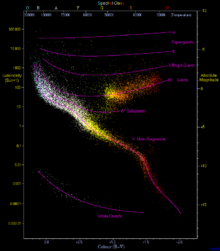| Observation data Epoch J2000.0 Equinox J2000.0 | |
|---|---|
| Constellation | Ophiuchus |
| Right ascension | 17 04 27.84 ± 5.62 |
| Declination | −28° 34′ 57.64″ ± 3.16 |
| Apparent magnitude (V) | 6.7258 ± 0.005 |
| Characteristics | |
| Spectral type | K0V |
| B−V color index | 0.814 ± 0.034 |
| Astrometry | |
| Radial velocity (Rv) | 14.2972 ± 0.0003 km/s |
| Proper motion (μ) | RA: 83.76 ± 0.64 mas/yr Dec.: -268.69 ± 0.36 mas/yr |
| Parallax (π) | 56.06 ± 0.50 mas |
| Distance | 58.2 ± 0.5 ly (17.8 ± 0.2 pc) |
| Absolute magnitude (MV) | 5.47 ± 0.02 |
| Details | |
| Mass | 0.97 ± 0.05 M☉ |
| Radius | 0.95 ± 0.03 R☉ |
| Luminosity | 0.68 −0.05 (log -0.169 ± 0.033) L☉ |
| Surface gravity (log g) | 4.40 ± 0.11 cgs |
| Temperature | 5423 ± 51 K |
| Metallicity | 0.31 ± 0.03 dex |
| Rotation | 42.6 ± 4.4 |
| Rotational velocity (v sin i) | 1.9 ± 0.5 km/s |
| Age | 3 - 8 Gyr |
| Other designations | |
| CD−28° 12769, GJ 652, HIP 83541, SAO 184990 | |
| Database references | |
| SIMBAD | data |
HD 154088 is a seventh magnitude metal-rich K-type main sequence star that lies approximately 58 light-years away in the constellation of Ophiuchus. The star is orbited by a hot Super-Earth.
Properties

HD 154088 is a modestly bright star that lies at the bottom of Ophiuchus, near to the border with Scorpius and near to the plane of the Milky Way. The star was recognised as a high proper motion star during the last century, and early Earth-based parallax measurements such as that of the Gliese Catalogue of Nearby Stars indicated a distance of about 50 light-years.
The star has a spectral type of K0V, indicating that it is a main sequence star that is about 350 degrees cooler than the Sun. On the Hertzsprung-Russell diagram (left), the star lies slightly above the main sequence. This is because the star is very metal-rich; with an Fe/H of 0.3 dex the star has about twice the solar abundance of iron, which makes HD 154088 fall into the somewhat vague group of super metal-rich (SMR) stars. The giant planet occurrence rate of Fe/H = 0.3 stars is on the order of 30%, but HD 154088 is not currently known to host any giant planets.
HD 154088 has a pronounced magnetic field. It also has a magnetic cycle similar to the Sun, though its length is not well constrained.
The survey in 2015 have ruled out the existence of any additional stellar companions at projected distances from 8 to 119 astronomical units.
Planetary system
A planet orbiting HD 154088 discovered with the HARPS spectrograph was announced in September 2011. With a minimum mass of 6 Earth masses, the companion falls into the regime of Super-Earths.
| Companion (in order from star) |
Mass | Semimajor axis (AU) |
Orbital period (days) |
Eccentricity | Inclination | Radius |
|---|---|---|---|---|---|---|
| b | ≥6.15 ± 0.86 M🜨 | 0.1316 ± 0.0021 | 18.596 ± 0.021 | 0.38 ± 0.15 | — | — |
HD 154088 is also being observed under the Keck Eta-Earth radial velocity survey. HD 154088 b is a close match for planet candidate 1 (orbital period = 18.1 days, minimum mass = 6.5 M🜨), so they may be the same detection. The planet existence was finally confirmed in 2021.
References
- ^ van Leeuwen, F. (2007). "Validation of the new Hipparcos reduction". Astronomy and Astrophysics. 474 (2): 653–664. arXiv:0708.1752. Bibcode:2007A&A...474..653V. doi:10.1051/0004-6361:20078357. S2CID 18759600.
- ^ Mayor, M.; et al. (2011). "The HARPS search for southern extra-solar planets XXXIV. Occurrence, mass distribution and orbital properties of super-Earths and Neptune-mass planets". arXiv:1109.2497. Bibcode:2011arXiv1109.2497M.
{{cite journal}}: Cite journal requires|journal=(help) - ^ Fossati, L.; et al. (2013). "Detection of a magnetic field in three old and inactive solar-like planet-hosting stars". Astronomy. 551: A85. arXiv:1302.0879. Bibcode:2013A&A...551A..85F. doi:10.1051/0004-6361/201220997. S2CID 53377473.
- Takeda, Genya; et al. (2007). "Structure and Evolution of Nearby Stars with Planets. II. Physical Properties of ~1000 Cool Stars from the SPOCS Catalog". The Astrophysical Journal Supplement Series. 168 (2): 297–318. arXiv:astro-ph/0607235. Bibcode:2007ApJS..168..297T. doi:10.1086/509763. S2CID 18775378.
- ^ Valenti, J. A.; Fischer, D. A. (2005). "Spectroscopic Properties of Cool Stars (SPOCS). I. 1040 F, G, and K Dwarfs from Keck, Lick, and AAT Planet Search Programs". The Astrophysical Journal Supplement Series. 159 (1): 141–166. Bibcode:2005ApJS..159..141V. doi:10.1086/430500.
- ^ Lovis, C.; et al. (2011). "The HARPS search for southern extra-solar planets. XXXI. Magnetic activity cycles in solar-type stars: statistics and impact on precise radial velocities". arXiv:1107.5325. Bibcode:2011arXiv1107.5325L.
{{cite journal}}: Cite journal requires|journal=(help) - Mugrauer, M.; Ginski, C. (12 May 2015). "High-contrast imaging search for stellar and substellar companions of exoplanet host stars". Monthly Notices of the Royal Astronomical Society. 450 (3): 3127–3136. Bibcode:2015MNRAS.450.3127M. doi:10.1093/mnras/stv771. hdl:1887/49340. Retrieved 19 June 2020.
- Howard, Andrew A.; et al. (2010). "The Occurrence and Mass Distribution of Close-in Super-Earths, Neptunes, and Jupiters". Science. 330 (6004): 653–655. arXiv:1011.0143. Bibcode:2010Sci...330..653H. doi:10.1126/science.1194854. PMID 21030652. S2CID 34792507.
- Unger, N.; Ségransan, D.; Queloz, D.; Udry, S.; Lovis, C.; Mordasini, C.; Ahrer, E.; Benz, W.; Bouchy, F.; Delisle, J.-B.; Díaz, R. F.; Dumusque, X.; Lo Curto, G.; Marmier, M.; Mayor, M.; Pepe, F.; Santos, N. C.; Stalport, M.; Alonso, R.; Collier Cameron, A.; Deleuil, M.; Figueira, P.; Gillon, M.; Moutou, C.; Pollacco, D.; Pompei, E. (2021), "The HARPS search for southern extra-solar planets", Astronomy & Astrophysics, 654: A104, arXiv:2108.10198, Bibcode:2021A&A...654A.104U, doi:10.1051/0004-6361/202141351